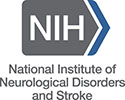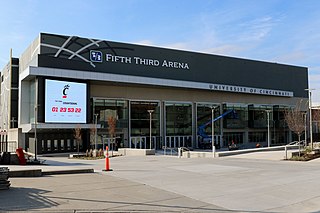Related Research Articles

The University of California, San Francisco (UCSF) is a public land-grant research university in San Francisco, California. It is part of the University of California system and is dedicated entirely to health science and life science. It conducts research and teaching in medical and biological sciences.

The National Institute of Neurological Disorders and Stroke (NINDS) is a part of the U.S. National Institutes of Health (NIH). It conducts and funds research on brain and nervous system disorders and has a budget of just over US$2.03 billion. The mission of NINDS is "to reduce the burden of neurological disease—a burden borne by every age group, every segment of society, and people all over the world". NINDS has established two major branches for research: an extramural branch that funds studies outside the NIH, and an intramural branch that funds research inside the NIH. Most of NINDS' budget goes to fund extramural research. NINDS' basic science research focuses on studies of the fundamental biology of the brain and nervous system, genetics, neurodegeneration, learning and memory, motor control, brain repair, and synapses. NINDS also funds clinical research related to diseases and disorders of the brain and nervous system, e.g. AIDS, Alzheimer's disease, epilepsy, muscular dystrophy, multiple sclerosis, Parkinson's disease, spinal cord injury, stroke, and traumatic brain injury.

The National Institute for Occupational Safety and Health is the United States federal agency responsible for conducting research and making recommendations for the prevention of work-related injury and illness. NIOSH is part of the Centers for Disease Control and Prevention (CDC) within the U.S. Department of Health and Human Services. Despite its name, it is not part of either the National Institutes of Health nor OSHA. Its current director is John Howard.

The University of Cincinnati is a public research university in Cincinnati, Ohio, United States. Founded in 1819 as Cincinnati College, it is the oldest institution of higher education in Cincinnati and has an annual enrollment of over 50,000 students, making it the second largest university in Ohio. It is part of the University System of Ohio. The university's primary uptown campus and medical campus are located in the Heights and Corryville neighborhoods, with branch campuses located in Batavia and Blue Ash, Ohio.

James Gamble Nippert Memorial Stadium is an outdoor stadium in Cincinnati, Ohio, on the campus of the University of Cincinnati. Primarily used for American football, it is the home field of the Cincinnati Bearcats football team. The stadium has also been used as a soccer venue, serving as the home of FC Cincinnati of Major League Soccer from their inaugural 2016 USL season through the 2020 MLS season, following which they moved to TQL Stadium. Nippert Stadium has a current seating capacity of 38,088 following the expansion and renovation performed in 2014, and the 2017 removal of corner seats to accommodate FC Cincinnati during their transition to the MLS. The stadium began in 1901 with a rudimentary for and field surface, with permanent concrete stands built along each sideline for the 1915 season and a complete horseshoe stadium completed in 1924, making it the fourth-oldest playing site and fifth-oldest stadium in college football, respectively.
David Gil Amaral is a professor of psychiatry at the University of California, Davis, United States, and since 1998 has been the research director at the M.I.N.D. Institute, an affiliate of UC Davis, engaged in interdisciplinary research into the causes and treatment of autism and related neurodevelopmental disorders. Amaral joined the UC Davis faculty as a professor in the Department of Psychiatry and the Center for Neuroscience and as an investigator at the California Regional Primate Research Center in 1991. Since 1995, he has been a professor of psychiatry in the UC Davis School of Medicine, with an appointment to the Center for Neuroscience.
The UC Davis MIND Institute is a research and treatment center affiliated with the University of California, Davis, with facilities located on the UC Davis Medical Center campus in Sacramento, California. The institute is a consortium of scientists, educators, physicians and parents dedicated to researching the causes of and treatments for autism spectrum disorders, fragile X syndrome, and other neurodevelopmental disorders. The director of the MIND institute is Dr. Leonard Abbeduto.

Fifth Third Arena is an indoor arena in Cincinnati, Ohio, United States. The arena opened in 1989 and is located on the campus of the University of Cincinnati. It primarily serves as the home venue for the Cincinnati Bearcats men's basketball, women's basketball, and women's volleyball teams and hosts other events. It is located in the Myrl H. Shoemaker Center, which was also the name of the arena until 2005, when it was named for Cincinnati-based Fifth Third Bank.

Bernadine Patricia Healy was an American cardiologist and the first female director of the National Institutes of Health (NIH).

The Lou Ruvo Center for Brain Health (LRCBH), officially the Cleveland Clinic Lou Ruvo Center for Brain Health, opened on May 21, 2010, in Las Vegas, Nevada. It is operated by the Cleveland Clinic and was designed by Frank Gehry.

The Michael J. Fox Foundation for Parkinson's Research aims to find a cure for Parkinson's disease (PD) founded in 2000 by Michael J. Fox. It concentrates on funding research and ensuring the development of improved therapies for people with Parkinson's.
The University of Cincinnati Academic Health Center (AHC) is a collection of health colleges and institutions of the University of Cincinnati, Cincinnati, Ohio. It trains health care professionals and provides research and patient care. AHC has strong ties to UC Health, which includes the University of Cincinnati Medical Center and West Chester Hospital.
The Mental Health Research Institute (MHRI) is a former Australian medical research institute that was focused upon improving the diagnosis, treatment and prevention of major mental disorders. The MHRI was active between 1956 and 2012, when it was merged with the Florey Neuroscience Institutes to form the Florey Institute of Neuroscience and Mental Health. Based in Melbourne, Victoria, the research efforts of the MHRI were focused on understanding schizophrenia, bipolar and major mood disorders, and Alzheimer's disease.
The Davis Phinney Foundation is a non-profit with a mission to help people with Parkinson's live well with the disease. It was founded in 2004 by Davis Phinney, a former professional road bicycle racer and Olympic medal winner. Today, Davis is an inspirational figure in the cycling community and people living with Parkinson's.
Pelotonia is an organization of events, centered around a two-day bicycle ride in the Columbus, Ohio area, to raise funds for cancer research at the Ohio State University Comprehensive Cancer Center – The James. Pelotonia, the Ride, includes a weekend of cycling, entertainment and volunteerism. As a 501(c)(3) not-for-profit organization, Pelotonia facilitates all of riders' and fundraisers' donation money contributing to cancer research, while corporate and philanthropic partners fund the administrative staff and functions.

Alim Louis Benabid is a French-Algerian emeritus professor, neurosurgeon and member of the French Academy of Sciences, who has had a global impact in the development of deep brain stimulation (DBS) for Parkinson's disease and other movement disorders. He became emeritus professor of biophysics at the Joseph Fourier University in Grenoble in September 2007, and chairman of the board of the Edmond J. Safra Biomedical Research Center in 2009 at Clinatec, a multidisciplinary institute he co-founded in Grenoble that applies nanotechnologies to neurosciences.
The Tianqiao and Chrissy Chen Institute is a non-profit institute founded by husband and wife Tianqiao Chen and Chrissy Luo with the aim of supporting study into the human brain. In 2016 the couple committed US$1 billion to support the institute’s work, which focuses on research in three core areas – brain discovery, brain treatment and brain development. Towards that end, the institute supports interdisciplinary research concerning neuroscience, particularly research on brain mechanics, perception, and the impact of perception on behavior and well-being.
Ali R. Rezai is an American neurosurgeon and neuroscientist. His work and research has focused on neuromodulation treatments for patients with neurological and mental health conditions, including neuromodulation techniques such as deep brain stimulation (DBS) through brain chip implants to treat Parkinson's disease tremors, obsessive–compulsive disorder, Alzheimer's disease, traumatic brain injury, spinal cord injury, and addiction.
The Parkinson's Foundation is a national organization that funds research and provides educational resources to Parkinson’s disease patients and caregivers. The Parkinson's Foundation was established in 2016 through the merger of the National Parkinson Foundation and the Parkinson's Disease Foundation. The Parkinson's Foundation has headquarters in Miami and New York City, in addition to 17 chapters throughout the United States.
John McLellan Tew, Jr. is an American neurosurgery specialist known for his work in treating brain tumors, intracranial brain aneurysms, and trigeminal neuralgia. He served as president of major American neurosurgical organizations, co-authored four neurosurgical textbooks, and trained more than 60 neurosurgical residents.
References
- ↑ "Phinney To Headline Fund-Raiser". The Cincinnati Post. Cincinnati, OH. 22 June 2007. Archived from the original on 29 June 2014. Retrieved 21 May 2013.
- ↑ "Sunflower Revolution Funds Parkinson's Projects". U of C Health News. 19 December 2008. Archived from the original on 2010-06-13. Retrieved 21 May 2013.
- ↑ Hemmerle, Ann M.; Herman, James P.; Seroogy, Kim B. (January 2012). "Stress, Depression and Parkinson's Disease". Experimental Neurology. 233 (1): 79–86. doi:10.1016/j.expneurol.2011.09.035. ISSN 0014-4886. PMC 3268878 . PMID 22001159.
- ↑ "Sunflower Rev It Up Anywhere Symposium". UC Health Media Room. 22 August 2020. Retrieved 3 March 2021.